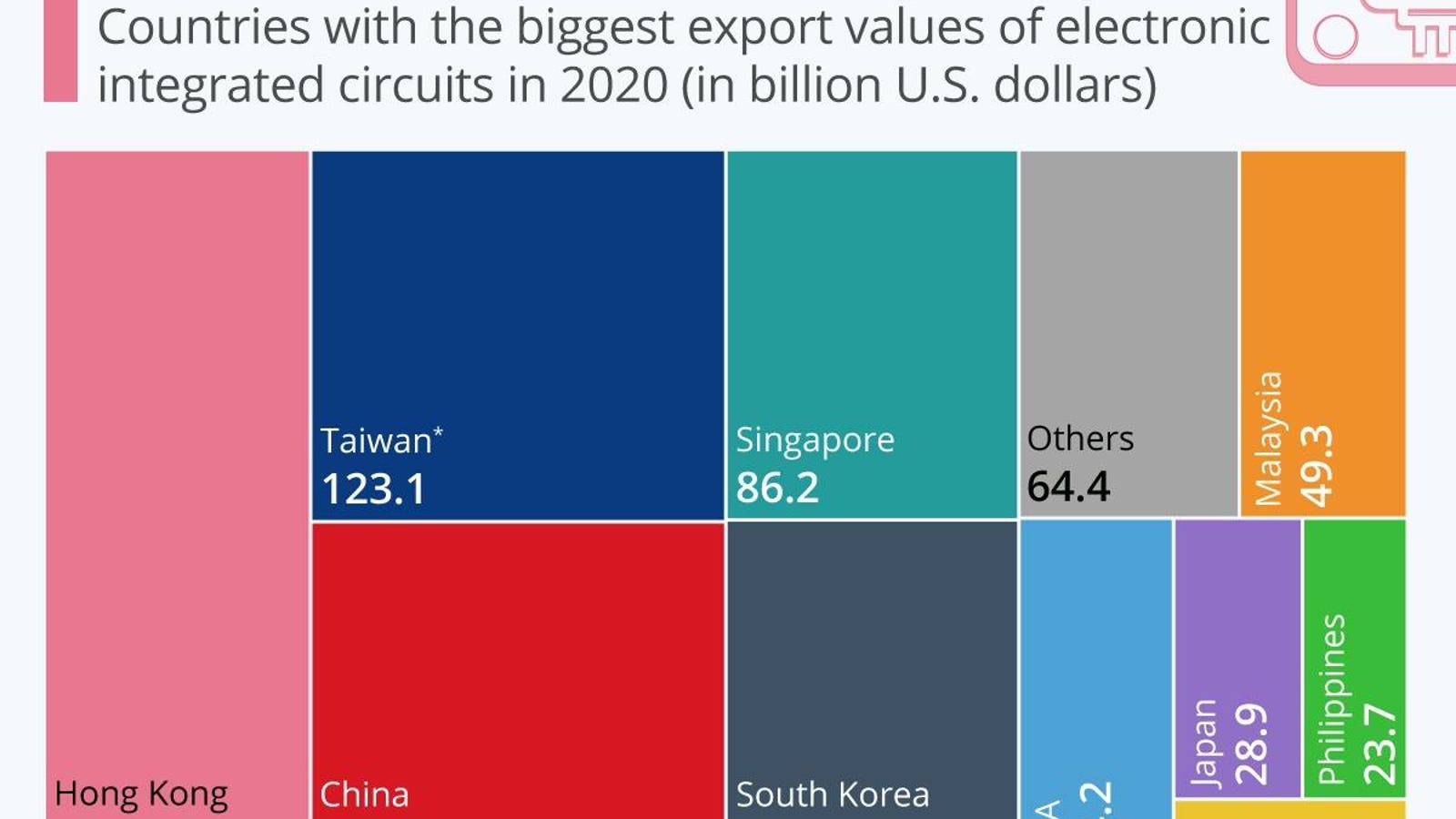Greater China Dominates Global Microchip Exports [Infographic]
Katharina Buchholz
Jul 27, 2022,12:18pm ED
The so-called Chips+ bill passed the U.S. Senate on Tuesday and has a good chance of becoming law as it moved on to the House. As fears of a confrontation with China are heightening, negotiations that lasted more than a year are finally coming to fruition for the bill which is looking to increase the competitiveness of the U.S. microchip industry, thereby alleviating dependency on Greater China and the shortage of microchips felt globally.
According to Yahoo News, the cost of the bill is still being calculated, but is expected to come in at around $79 billion spent over the next ten years. This includes a key provision of $50 billion that will go directly to U.S. chipmakers for the expansion of facilities as well as for research and development.

This chart shows the countries with the biggest export values of electronic integrated circuits in 2020 (in billion U.S. dollars).
For now, Mainland China, Hong Kong and Taiwan are dominating global microchip production, which allows them to control half of the worldwide export market. As seen in numbers available from the UN Comtrade database, Greater China exports of microchips totaled almost $400 billion in the pandemic year of 2020—the latest for which full data is available. The U.S. exported semiconductors worth around $44 billion the same year, still the seventh-highest in the world.
In 2021, exports out of Greater China were back up to around $522 billion, while those out of the U.S. rose to just below $53 billion.
Rapid, ongoing shift in chip production
As recently as 1990, the U.S. still produced almost 40 percent of semiconductors globally, with Europe responsible for roughly another 40 percent. But the growth of cheaper production facilities in Asia set in motion a trend that quickly changed where microchips typically come from. Just ten years later, in the year 2000, Europe and the U.S. together contributed only slightly more than 40 percent to global semiconductor manufacturing, with Japan, South Korea and Taiwan taking up almost all the rest of it. By 2010, Mainland China had already carved out a small share of the market. That subsequently grew to around 15 percent by 2020 and is expected to expand to as much as a quarter of global production by 2030, taking away market shares from competitors in the U.S., Europe and Asia all at the same time.
As disruptions to supply chains caused microchip shortages during the Covid-19 pandemic, several countries started initiatives looking to reverse the above trend and boost production of the critical asset at home. Before the U.S., Japan and the EU had already announced actions to produce more semiconductors domestically. The fast growth of Mainland China’s chip production will be hard to catch up to, however.

 www.forbes.com
www.forbes.com
Katharina Buchholz
Jul 27, 2022,12:18pm ED
The so-called Chips+ bill passed the U.S. Senate on Tuesday and has a good chance of becoming law as it moved on to the House. As fears of a confrontation with China are heightening, negotiations that lasted more than a year are finally coming to fruition for the bill which is looking to increase the competitiveness of the U.S. microchip industry, thereby alleviating dependency on Greater China and the shortage of microchips felt globally.
According to Yahoo News, the cost of the bill is still being calculated, but is expected to come in at around $79 billion spent over the next ten years. This includes a key provision of $50 billion that will go directly to U.S. chipmakers for the expansion of facilities as well as for research and development.
This chart shows the countries with the biggest export values of electronic integrated circuits in 2020 (in billion U.S. dollars).
For now, Mainland China, Hong Kong and Taiwan are dominating global microchip production, which allows them to control half of the worldwide export market. As seen in numbers available from the UN Comtrade database, Greater China exports of microchips totaled almost $400 billion in the pandemic year of 2020—the latest for which full data is available. The U.S. exported semiconductors worth around $44 billion the same year, still the seventh-highest in the world.
In 2021, exports out of Greater China were back up to around $522 billion, while those out of the U.S. rose to just below $53 billion.
Rapid, ongoing shift in chip production
As recently as 1990, the U.S. still produced almost 40 percent of semiconductors globally, with Europe responsible for roughly another 40 percent. But the growth of cheaper production facilities in Asia set in motion a trend that quickly changed where microchips typically come from. Just ten years later, in the year 2000, Europe and the U.S. together contributed only slightly more than 40 percent to global semiconductor manufacturing, with Japan, South Korea and Taiwan taking up almost all the rest of it. By 2010, Mainland China had already carved out a small share of the market. That subsequently grew to around 15 percent by 2020 and is expected to expand to as much as a quarter of global production by 2030, taking away market shares from competitors in the U.S., Europe and Asia all at the same time.
As disruptions to supply chains caused microchip shortages during the Covid-19 pandemic, several countries started initiatives looking to reverse the above trend and boost production of the critical asset at home. Before the U.S., Japan and the EU had already announced actions to produce more semiconductors domestically. The fast growth of Mainland China’s chip production will be hard to catch up to, however.

Greater China Dominates Global Microchip Exports [Infographic]
As fears of a confrontation with China are heightening, negotiations that lasted more than a year are finally coming to fruition for the Chips+ bill that is looking to increase the competitiveness of the U.S. microchip industry, thereby alleviating dependency on China and the shortage of microchips.
 www.forbes.com
www.forbes.com




